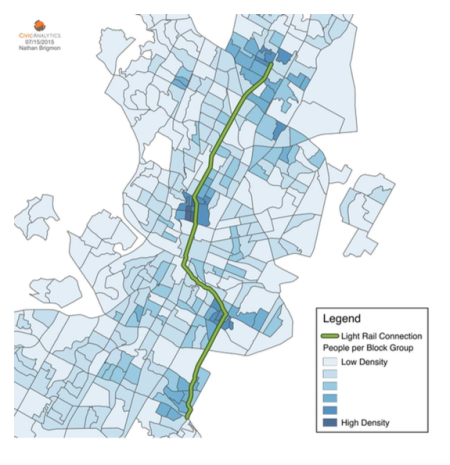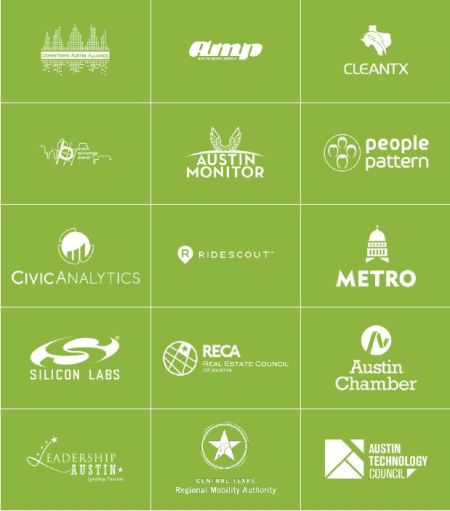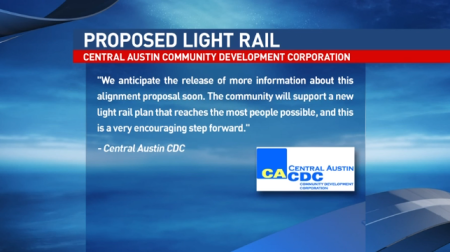
Another major Austin community recommendation for light rail transit in Guadalupe-Lamar
12 November 2015
Light rail transit alignment following North Lamar Blvd., Guadalupe St., Riverside Dr., and Pleasant Valley Rd. as proposed by MobilityATX.
♦
The prospect of a light rail transit (LRT) starter line project in the Guadalupe-Lamar corridor has received another huge boost in a recommendation from MobilityATX, an eminent Austin-focused civic organization that describes itself as “a community-engagement initiative sponsored by both public and private community partners that invites the public to create and shape public policy solutions to Austin’s transportation woes.” The recommendation for Guadalupe-Lamar light rail is included as one of ten “Popular Ideas” resulting from a community input process in the spring and summer of 2015, elaborated in a Mobility ATX Findings Report produced by Glasshouse Policy “in conjunction with community partners and stakeholders …” and packed with supportive factual documentation. The report was originally released in mid-October.
As the report relates, “Part of the MobilityCity umbrella initiative, MobilityATX is a privately-funded online and in-person platform for all Austinites to explore discrete topics that impact Austin mobility.” And regarding the background of the report: “Lasting from April to July, MobilityATX curated a conversation by inviting the public, Austin community leaders, regional transportation brands, mobility influencers and regional employers to join this effort to turn citizen-sourced priorities into effective policy solutions.”
The report’s proposed LRT alignment, shown in its map at the top of this post (see above), includes the Guadalupe-Lamar segment (which we’ve consistently advocated as the most feasible LRT starter line), then crosses Lady Bird Lake (the Colorado River) to include a possible line branching into southeast Austin. The proposed route follows North Lamar Blvd. and Guadalupe St. (and presumably the Guadalupe-Lavaca street pair downtown), then crosses the river via a bridge that appears to be roughly located parallel to either the South First St. (Drake) Bridge, or the Congress Avenue Bridge — or possibly it involves an adaptation of either bridge to include lanes for LRT (as we’ve also proposed).
Heading southeast, the proposed route appears to follow Riverside Drive, then turns southward to follow Pleasant Valley Road and then other unspecified alignments south of Ben White Blvd. (State Highway 71). Population density levels shown on the route map indicate that areas of high density are connected by the alignment.
In presenting the proposal, the report notes that
Despite two major defeats for light rail in recent history, it’s clear that there is sustained community interest in exploring and developing an expansive light rail system in Austin. According to the 2015 Zandan Poll of Austin-area residents, 63% of respondents would favor seeing an increase in taxes to construct an above ground rail system. In addition, Austin’s commuter rail line, the MetroRail Red Line, has seen dramatic increases in ridership. …
…
We must get cracking on planning a light-rail line that will serve the greatest number of riders on day one, and going forward. We can’t give up on light rail just because the city floated a bad plan and voters shot that bad plan down. Bus Rapid Transit is not a substitute.
(Emphasis added in above quotations. Original quote implied that MetroRail began operation in 2008; in actuality, MetroRail opened in spring of 2010.)
Supported by a consortium of leading civic “partners”, including the Downtown Austin Alliance, the Greater Austin Chamber of Commerce, Capital Metro (the region’s transit authority), RECA (the Real Estate Council of Austin), Leadership Austin, the Central Texas Regional Mobility Authority, the Austin Monitor (online news media), and a variety of mainly tech-involved businesses and other organizations, MobilityATX clearly represents much of the top civic leadership of the city. (See complete list of partners in the graphic below, from the Findings Report).
In his Foreword to the report, City of Austin Mayor Steve Adler emphasized:
As Austin rapidly evolves, we must continually innovate new approaches to engage Austinites in the discussions that shape City policy. Given the participation in the MobilityATX initiative, it’s clear Austinites are anxious to contribute their ideas for transforming mobility, and how it impacts our commutes, our economy, and our lives.
…
The final Glasshouse Policy report on this process provides me, my colleagues on the Austin City Council, private employers, public agencies, and all Austinites, with a new community perspective from which to approach our shared mobility challenge. We need to add this perspective to those gathered from other community engagement efforts to
ensure that we hear from all Austinites in every district as we plan for our mobility future. I’d also like to thank the array of public and private stakeholders for their vision and support of this effort, including business, government, and civic leaders like RideScout CEO Joseph Kopser, Dewitt Peart of the Downtown Austin Alliance, and Capital Metro CEO Linda Watson.Each of you who took part in MobilityATX confirmed that all Austinites have something to say and deserve a forum in which to say it. I look forward to working with the MobilityATX partners to ensure Austin leads the global conversation on what constitutes a smarter, more connected city, and continues to reflect the innovators and entrepreneurs that call Austin home.
Mobility ATX’s LRT recommendation notes that
After the defeat of Proposition 1 in November, there has been no significant movement to develop a new light rail plan for Austin. In order to build new light rail in Austin, bond funding would have to be secured for a new plan. There is no official public effort underway to develop a new light rail plan.
Austinites are anticipating that city and regional transportation authorities will develop a new plan for a light rail system, a process that should include sustained and inclusive community input in the planning and development of that system. Beyond all other data collected, the expectation of inclusion is most critical to understanding Austin’s evolving mobility constituency.
And it concludes with what seems a call for action (emphasis added):
Contact your Council Member. Like the Bicycle Master Plan, building a light rail line requires a bond election. In order for a bond to appear on the ballot, City Council must vote to put that bond proposal up to popular vote. Once City Council does that, a simple majority in a popular election is required to pass the bond proposal.
The MobilityATX Findings Report has been received enthusiastically by proponents of Guadalupe-Lamar light rail, including Texas Association for Public Transportation, Austin Rail Now, and the Central Austin Community Development Corporation (CACDC), which have long advocated for such a project. A report on KEYE-TV News included a graphic (see below) with an excerpt from a CACDC statement that commented, in part, “The community will support a new light rail plan that reaches the most people possible, and this is a very encouraging step forward.”
Hopefully, the MobilityATX report’s recommendation will add significant momentum to the ongoing campaign for an initial LRT starter line project in the crucial Guadalupe-Lamar travel corridor. ■



The MobilityATX Glasshouse Policy report at
https://mobilityatx.com/reports/findings.pdf is so shallow it doesn’t contain a thimble of realistic solutions for improving people mobility.
It is obvious that the Most Popular Ideas Upvotes votes were dominated by interest groups representing a small number who rallied their constituents to chime in.
The #1 vote to Fully Fund the Bicycle Master Plan got almost twice the votes of any other topic. Bike commuters’ tiny % of transportation modes used points to the flaw in this method, as Austin drowns in traffic congestion.
#2 was burying IH35 which won’t do anything towards reducing congestion.
The report’s section on Conversation Corps (a whopping demographic – 18 conversations with 72 participants) outlines the obvious and undermines the cry for “rail at any cos”.
What it does do is clearly show the need for and value of the “from anywhere to anywhere anytime” public transit solution called Cellular Mass Transit http://www.CMT4Austin.org – offered consultant free to Austinites by our own citizen
Richard Shultz .
Quickly doable within the CapMetro capital and operating budget, using all existing infrastructure, adding small vans and drivers and neighborhood area transit centers, providing <10 minute waits, 50% faster trip time, 2x more riders to reduce the taxpayer subsidy, CMT is THE TRANSIT SOLUTION everyone should demand be embraced and implemented for the good of the entire community. LETS DO IT!